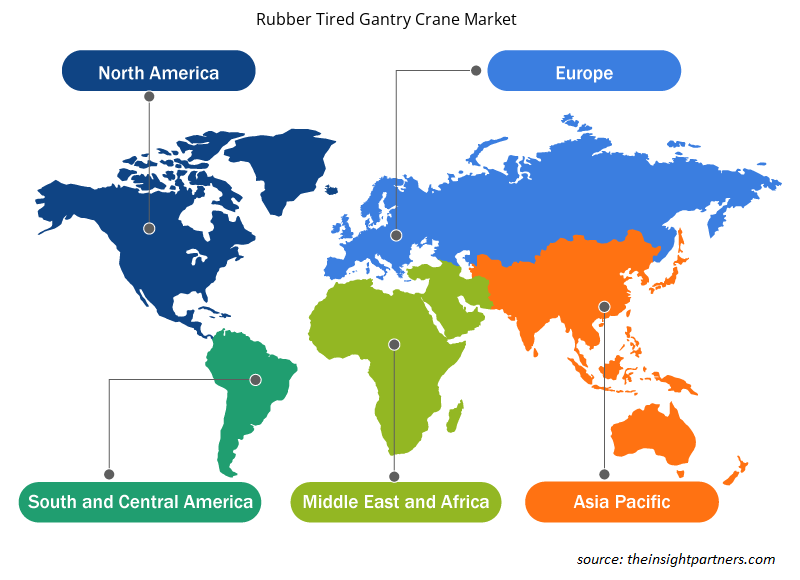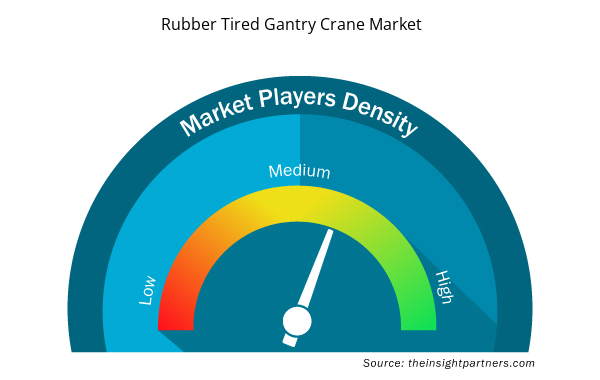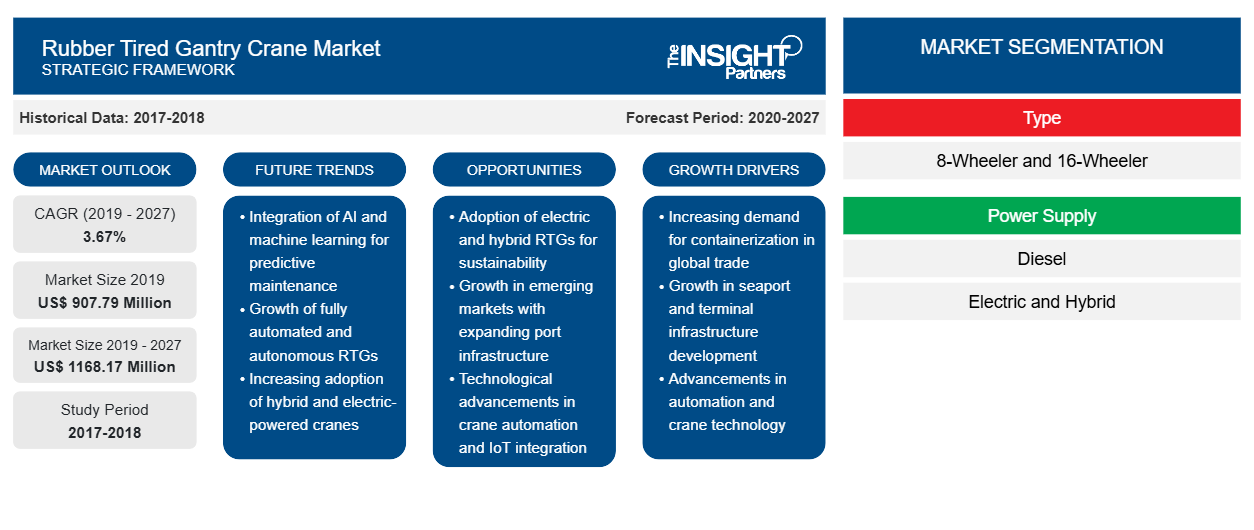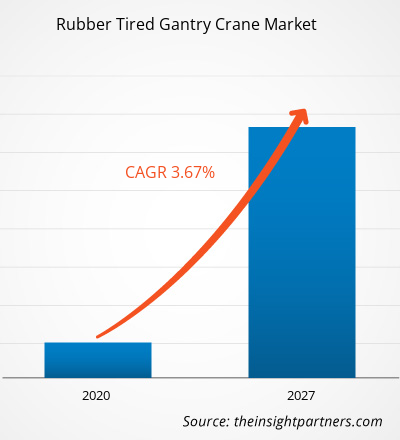ゴムタイヤ式ガントリークレーン市場は、2019年に9億779万米ドルと評価され、2027年までに1億16817万米ドルに達すると予測されています。また、2020年から2027年にかけて3.67%のCAGRで成長すると予想されています。
過去には、発展途上国は原材料の供給国でした。しかし、貿易の形態の変化により、世界中の発展途上国に新たな役割が与えられ、予測期間中にタイヤ式ガントリークレーン市場は大幅な成長率を示すことが予測されています。市場の成長は、主に海上貿易の需要の増加によるもので、中国を含む発展途上国は現在、海上貨物の重要な輸入国および輸出国として台頭しており、アジアが最大の貿易地域となっています。
さらに、ゴムタイヤ式ガントリークレーン市場は、港湾開発に対する政府の好意的な取り組みによって推進されています。港湾は、うまく機能すれば経済の車輪となります。今日では、港湾の目的は限定されているだけでなく、物流プラットフォームにまで拡大しています。港湾は国の対外貿易の要であるため、港湾の生産性は国際貿易において重要です。いくつかの政府政策が実施されており、それが予測期間中に世界のゴムタイヤ式ガントリークレーン市場を牽引することになります。
ヨーロッパは2019年にゴムタイヤ式ガントリークレーン市場をリードし、予測期間中もその優位性を維持すると予想されています。ヨーロッパの港では、汚染と温室効果ガスの排出を削減するために電動RTGを採用しています。この地域の政府規制により、海上輸送における炭素排出検証などの電動コンテナハンドリング機器の採用が可能になっています。ヨーロッパは、機械、車両、航空機、燃料、非鉄金属、繊維、化学薬品、衣類、原油などの製品や資産の取引量が多いです。ヨーロッパは取引量で第1位であり、そのおかげでこの地域はゴムタイヤ式ガントリークレーンの世界市場をリードしています。
要件に合わせてレポートをカスタマイズする
このレポートの一部、国レベルの分析、Excelデータパックなど、あらゆるレポートを無料でカスタマイズできます。また、スタートアップや大学向けのお得なオファーや割引もご利用いただけます。
- このレポートの主要な市場動向を入手してください。この無料サンプルには、市場動向から見積もりや予測に至るまでのデータ分析が含まれます。
COVID-19パンデミックがゴムタイヤ式ガントリークレーン市場に与える影響
COVID-19危機は世界中の産業に影響を及ぼしており、世界経済は2020年だけでなく2021年にも最悪の打撃を受けると予想されています。この流行は、家電製品、半導体、自動車、ITインフラなどの一次産業に大きな混乱を引き起こしています。これらの産業はすべて、ゴムタイヤ式ガントリークレーンの主要な需要創出産業であるため、世界のゴムタイヤ式ガントリークレーン市場の成長にとって非常に重要です。工場の閉鎖、渡航禁止、貿易禁止、国境封鎖は、さまざまな消費者向け電子製品と部品の製造と販売の両方に影響を与えています。世界の電子機器および半導体産業は、サプライチェーンの問題と製造停止により深刻な混乱に直面している主要産業の1つです。
市場分析
グリーンテクノロジーへの注目の高まり
市場参加者は、さまざまな地域での汚染および排出制限に関する厳しい政府規制のため、グリーンテクノロジーに注目しています。また、電動駆動装置を備えたRTGの使用は、消費電力を抑えるように最適化できます。クレーンでのバッテリーハイブリッドテクノロジーの使用は、燃料消費と有害な化石燃料の排出を大幅に削減することに焦点を当てています。港での荷役機器からのディーゼル燃料排出量の約10%は、RTGクレーンによって排出されます。より効率的なRTGの実装は、クレーン操作の環境への影響を直接的に軽減します。このテクノロジーは、排出量と運用の環境への影響を削減しながら効率を高める必要がある世界中の忙しい港湾運営者にとっての答えであり、温室効果ガス排出量の削減とターミナルでの騒音レベルの低減による運用コストの削減という追加のメリットも提供します。既存のRTGクレーンに後付けすることも、新規構築の一部として組み込むこともできる、ゴムタイヤガントリークレーンまたはRTG用のフライホイールエネルギー貯蔵テクノロジー。フライホイールは、コンテナを下ろすときに生成されるブレーキエネルギーを捕捉することで、燃料と排出量を削減します。
タイプベースの市場分析
タイプに基づいて、ゴムタイヤ式ガントリークレーンの世界市場は、8 輪車と 16 輪車の 2 つのセグメントに分けられます。各モデルには、8 輪車には 8W と 8WA、16 輪車には 16W と 16WA の 2 つのタイプがあります。2 つのモデルの主な違いは、アンチスウェイ システムの設計とガントリー ホイールの数です。16 タイヤ RTG クレーンには、より大きな移動領域が必要です。したがって、狭いスペースでは使用できません。8 タイヤ RTG クレーンの方が、狭いスペースに適しています。
電源ベースの市場分析
電力供給に基づいて、ゴムタイヤ式ガントリークレーンの世界市場は、ディーゼル、電動、ハイブリッドの 3 つのカテゴリに分類できます。世界的な排出量を最小限に抑えるための厳格な排出基準の実施、より効率的な電動車両の開発、および燃料価格の上昇により、世界中で電動およびハイブリッド RTG クレーンの需要が増加する可能性があります。電動 RTG クレーンはパフォーマンスが優れており、かなりの荷物を移動できます。このため、電動およびハイブリッド ゴムを使用したタイヤ式ガントリークレーンの人気がすぐに高まると予想されます。
製品開発は、企業が製品ポートフォリオを拡大するために最も一般的に採用されている戦略の 1 つです。Anupam industries limited、electromech material handling systems (India) Pvt. ltd、Konecranes、Liebherr、Kalmar は、顧客基盤を拡大し、ゴムタイヤ式ガントリークレーン市場で大きなシェアを獲得するための戦略を実行している主要企業であり、その結果、世界市場でブランド名を維持できます。
ゴムタイヤ式ガントリークレーン市場の地域別分析
予測期間を通じてゴムタイヤ式ガントリークレーン市場に影響を与える地域的な傾向と要因は、Insight Partners のアナリストによって徹底的に説明されています。このセクションでは、北米、ヨーロッパ、アジア太平洋、中東、アフリカ、南米、中米にわたるゴムタイヤ式ガントリークレーン市場のセグメントと地理についても説明します。

- ゴムタイヤ式ガントリークレーン市場の地域別データを入手
ゴムタイヤ式ガントリークレーン市場レポートの範囲
| レポート属性 | 詳細 |
|---|---|
| 2019年の市場規模 | 9億779万米ドル |
| 2027年までの市場規模 | 11億6,817万米ドル |
| 世界のCAGR(2019年 - 2027年) | 3.67% |
| 履歴データ | 2017-2018 |
| 予測期間 | 2020-2027 |
| 対象セグメント | タイプ別
|
| 対象地域と国 | 北米
|
| 市場リーダーと主要企業プロフィール |
|
市場プレーヤーの密度:ビジネスダイナミクスへの影響を理解する
ゴムタイヤ式ガントリークレーン市場は、消費者の嗜好の変化、技術の進歩、製品の利点に対する認識の高まりなどの要因により、エンドユーザーの需要が高まり、急速に成長しています。需要が高まるにつれて、企業は提供を拡大し、消費者のニーズを満たすために革新し、新たなトレンドを活用し、市場の成長をさらに促進しています。
市場プレーヤー密度とは、特定の市場または業界内で活動している企業または会社の分布を指します。これは、特定の市場スペースに、その市場規模または総市場価値に対してどれだけの競合相手 (市場プレーヤー) が存在するかを示します。
ゴムタイヤ式ガントリークレーン市場で事業を展開している主要企業は次のとおりです。
- アヌパム インダストリーズ リミテッド
- エレクトロメカニクスマテリアルハンドリングシステムズ(インド)株式会社
- カルマル
- コネクレーン
- リープヘル
免責事項:上記の企業は、特定の順序でランク付けされていません。

- ゴムタイヤ式ガントリークレーン市場のトップキープレーヤーの概要を入手
ゴムタイヤ式ガントリークレーン市場のセグメンテーション:
タイプ別
- 8輪車
- 16輪車
電源別
- ディーゼル
- 電気
- ハイブリッド
企業プロフィール
- アヌパム インダストリーズ リミテッド
- エレクトロメック マテリアル ハンドリング システムズ (インド) PVT. LTD
- カルマル
- コネクレーン
- リープヘル
- Mi-Jack製品。
- レバ インダストリーズ株式会社
- 上海振華重工業株式会社(ZPMC)
- TNT クレーン & リギング
- 三一グループ
- 過去2年間の分析、基準年、CAGRによる予測(7年間)
- PEST分析とSWOT分析
- 市場規模価値/数量 - 世界、地域、国
- 業界と競争環境
- Excel データセット



Report Coverage
Revenue forecast, Company Analysis, Industry landscape, Growth factors, and Trends

Segment Covered
This text is related
to segments covered.

Regional Scope
North America, Europe, Asia Pacific, Middle East & Africa, South & Central America

Country Scope
This text is related
to country scope.
よくある質問
Being mobile, RTGs are often powered by a 100 to 600 kW diesel generator (genset) system. Because of the lack of an electrical grid to dump energy when containers are lowered, they often have large resistor packs to dissipate the energy of a container that is lowering or decelerating quickly. Diesel-powered RTGs are notorious ports polluters, as they burn up to 10 gallons of diesel fuel per hour each. Due to their use of more fuel, volatility in fuel costs, and generation of gas emissions such as carbon dioxide and nitrogen oxides, Diesel rubber tired gantry cranes are usually environmentally and economically inefficient. Converting from diesel to electrified RTG cranes is one way to reduce carbon gas emissions and operating costs. The conversion of rubber tired gantry cranes from diesel to electric power, or switchable diesel / electric power, is an emerging trend in container ports around the world and one that has led Conductix-Wampfler to extensive field tests. While the RTG operates in a row of containers, it can only run on electric power, and the diesel engine can be switched off.
The Europe region led the rubber tired gantry cranes market in 2019. The major contributors to the rubber tired gantry cranes market in Europe are Germany, France, the UK, Russia, and Italy, among others. Europe's ports have adopted electric RTGs for reducing pollution and greenhouse gas emissions. Government regulations in this region have enabled the adoption of electrical container handling equipment, such as carbon emission verification in maritime transportation. Also, financial transparency regarding port investments has enabled port authorities to invest strategically in port infrastructure. European nations rank among the leading importers and exporters of commodities and goods. Europe accounts for a large volume of trade in products and assets, such as machinery, vehicles, aircraft, fuels, nonferrous metals, textiles, chemicals, clothing, and crude oils. Europe ranks first in trading, owing to which the region leads the global market for rubber tired gantry cranes.
The layout of trade has given a new role in developing countries across the globe. While in the past, developing countries were providers of raw materials. Nowadays, developing countries, including China, are emerging as important importers and exporters of goods by sea. This has led to an increase in the demand for seaborne trading. Rise in the growth of seaborne trade has been rising over the years. Asia region was, till now by far the biggest trading region. In 2018, 4.5 Bn tons of goods were loaded, and 6.7 Bn tons unloaded in Asian seaports. The other continents were noted less than half of these amounts. Over the years, developing economies still accounted for the largest share of global seaborne trade, both in terms of exports (goods loaded) and imports (goods unloaded). However, an important rise in the seaborne trading is assisting the rubber Tire gantry crane market across the globe. Moreover, an increase in in-country transportation of commodities and goods via trains is rising the global rubber Tire gantry crane market.
Trends and growth analysis reports related to Automotive and Transportation : READ MORE..
The List of Companies - Rubber Tired Gantry Cranes Market
- Anupam Industries Limited
- Electromech material handling systems (India) Pvt. Ltd
- Kalmar
- Konecranes
- Liebherr
- Mi-Jack Products
- Reva Industries Ltd
- Shanghai Zhenhua Heavy Industries CO., Ltd
- TNT Crane & Rigging
- Sany Group
The Insight Partners performs research in 4 major stages: Data Collection & Secondary Research, Primary Research, Data Analysis and Data Triangulation & Final Review.
- Data Collection and Secondary Research:
As a market research and consulting firm operating from a decade, we have published and advised several client across the globe. First step for any study will start with an assessment of currently available data and insights from existing reports. Further, historical and current market information is collected from Investor Presentations, Annual Reports, SEC Filings, etc., and other information related to company’s performance and market positioning are gathered from Paid Databases (Factiva, Hoovers, and Reuters) and various other publications available in public domain.
Several associations trade associates, technical forums, institutes, societies and organization are accessed to gain technical as well as market related insights through their publications such as research papers, blogs and press releases related to the studies are referred to get cues about the market. Further, white papers, journals, magazines, and other news articles published in last 3 years are scrutinized and analyzed to understand the current market trends.
- Primary Research:
The primarily interview analysis comprise of data obtained from industry participants interview and answers to survey questions gathered by in-house primary team.
For primary research, interviews are conducted with industry experts/CEOs/Marketing Managers/VPs/Subject Matter Experts from both demand and supply side to get a 360-degree view of the market. The primary team conducts several interviews based on the complexity of the markets to understand the various market trends and dynamics which makes research more credible and precise.
A typical research interview fulfils the following functions:
- Provides first-hand information on the market size, market trends, growth trends, competitive landscape, and outlook
- Validates and strengthens in-house secondary research findings
- Develops the analysis team’s expertise and market understanding
Primary research involves email interactions and telephone interviews for each market, category, segment, and sub-segment across geographies. The participants who typically take part in such a process include, but are not limited to:
- Industry participants: VPs, business development managers, market intelligence managers and national sales managers
- Outside experts: Valuation experts, research analysts and key opinion leaders specializing in the electronics and semiconductor industry.
Below is the breakup of our primary respondents by company, designation, and region:

Once we receive the confirmation from primary research sources or primary respondents, we finalize the base year market estimation and forecast the data as per the macroeconomic and microeconomic factors assessed during data collection.
- Data Analysis:
Once data is validated through both secondary as well as primary respondents, we finalize the market estimations by hypothesis formulation and factor analysis at regional and country level.
- Macro-Economic Factor Analysis:
We analyse macroeconomic indicators such the gross domestic product (GDP), increase in the demand for goods and services across industries, technological advancement, regional economic growth, governmental policies, the influence of COVID-19, PEST analysis, and other aspects. This analysis aids in setting benchmarks for various nations/regions and approximating market splits. Additionally, the general trend of the aforementioned components aid in determining the market's development possibilities.
- Country Level Data:
Various factors that are especially aligned to the country are taken into account to determine the market size for a certain area and country, including the presence of vendors, such as headquarters and offices, the country's GDP, demand patterns, and industry growth. To comprehend the market dynamics for the nation, a number of growth variables, inhibitors, application areas, and current market trends are researched. The aforementioned elements aid in determining the country's overall market's growth potential.
- Company Profile:
The “Table of Contents” is formulated by listing and analyzing more than 25 - 30 companies operating in the market ecosystem across geographies. However, we profile only 10 companies as a standard practice in our syndicate reports. These 10 companies comprise leading, emerging, and regional players. Nonetheless, our analysis is not restricted to the 10 listed companies, we also analyze other companies present in the market to develop a holistic view and understand the prevailing trends. The “Company Profiles” section in the report covers key facts, business description, products & services, financial information, SWOT analysis, and key developments. The financial information presented is extracted from the annual reports and official documents of the publicly listed companies. Upon collecting the information for the sections of respective companies, we verify them via various primary sources and then compile the data in respective company profiles. The company level information helps us in deriving the base number as well as in forecasting the market size.
- Developing Base Number:
Aggregation of sales statistics (2020-2022) and macro-economic factor, and other secondary and primary research insights are utilized to arrive at base number and related market shares for 2022. The data gaps are identified in this step and relevant market data is analyzed, collected from paid primary interviews or databases. On finalizing the base year market size, forecasts are developed on the basis of macro-economic, industry and market growth factors and company level analysis.
- Data Triangulation and Final Review:
The market findings and base year market size calculations are validated from supply as well as demand side. Demand side validations are based on macro-economic factor analysis and benchmarks for respective regions and countries. In case of supply side validations, revenues of major companies are estimated (in case not available) based on industry benchmark, approximate number of employees, product portfolio, and primary interviews revenues are gathered. Further revenue from target product/service segment is assessed to avoid overshooting of market statistics. In case of heavy deviations between supply and demand side values, all thes steps are repeated to achieve synchronization.
We follow an iterative model, wherein we share our research findings with Subject Matter Experts (SME’s) and Key Opinion Leaders (KOLs) until consensus view of the market is not formulated – this model negates any drastic deviation in the opinions of experts. Only validated and universally acceptable research findings are quoted in our reports.
We have important check points that we use to validate our research findings – which we call – data triangulation, where we validate the information, we generate from secondary sources with primary interviews and then we re-validate with our internal data bases and Subject matter experts. This comprehensive model enables us to deliver high quality, reliable data in shortest possible time.


 このレポートの無料サンプルを入手する
このレポートの無料サンプルを入手する